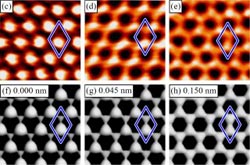New Technique Controls Graphite to Graphene Transition

The top three images of graphite are from the experiment and the lower three images were produced through theoretical calculations. The images from left to right show more displacement of the top layer of graphite and its transition to graphene. <br>
University of Arkansas physicists have found a way to systematically study and control the transition of graphite, the “lead” found in pencils, to graphene, one of the strongest, lightest and most conductive materials known, an important step in the process of learning to use this material in modern day technology.
Peng Xu, Paul Thibado, Yurong Yang, Laurent Bellaiche and their colleagues report their findings in the journal Carbon.
Physicists at the University of Manchester first isolated graphene, a one atom thick sheet of carbon atoms, by using Scotch tape to lift only the top layer off of the other layers of graphite. Electrons moving through graphite have mass and encounter resistance, but electrons moving through graphene are massless and encounter almost no resistance, which makes graphene an excellent candidate material for future energy needs and for quantum computing for enormous calculations while using little energy.
However, graphene is a new material only discovered in 2004, and many things remain unknown about its properties.
“The transition from graphite to graphene can be random,” said Xu. “Our idea was to control this.”
The researchers used a new technique called electrostatic manipulation scanning tunneling microscopy to “lift” the top layer of graphite, creating graphene. Scientists have traditionally used scanning tunneling microscopy on a stationary surface, but this new technique uses a moving surface to move between graphite and grapheme.
“Not only can we make it happen, but we can control the process,” Xu said.
Using this technique, the researchers can tell how much force it takes to create graphene and how much distance exists between graphene and the graphite as well as to track the total energy of the process.
How the electron acquires its mass is a fundamental topic and is related to particle physicists’ hunt for the Higgs boson, a long-hypothesized elementary particle that has predicted properties, such as a lack of spin and electric charge, but that does not have a predicted value for mass. Being able to move electrons between a massive and massless state allows scientists to study this duality and how it works. The level of control the scientists have over the process will allow them to figure out possible ways to use graphene for advancing this understanding.
Xu and his colleagues are researchers in the J. William Fulbright College of Arts and Sciences.
CONTACTS:
Peng Xu, physics
J. William Fulbright College of Arts and Sciences
479-575-6178, pxu@uark.edu
Melissa Lutz Blouin, senior director of academic communications
University Relations
479-575-55, blouin@uark.edu
Media Contact
More Information:
http://www.uark.eduAll latest news from the category: Materials Sciences
Materials management deals with the research, development, manufacturing and processing of raw and industrial materials. Key aspects here are biological and medical issues, which play an increasingly important role in this field.
innovations-report offers in-depth articles related to the development and application of materials and the structure and properties of new materials.
Newest articles

Webb captures top of iconic horsehead nebula in unprecedented detail
NASA’s James Webb Space Telescope has captured the sharpest infrared images to date of a zoomed-in portion of one of the most distinctive objects in our skies, the Horsehead Nebula….

Cost-effective, high-capacity, and cyclable lithium-ion battery cathodes
Charge-recharge cycling of lithium-superrich iron oxide, a cost-effective and high-capacity cathode for new-generation lithium-ion batteries, can be greatly improved by doping with readily available mineral elements. The energy capacity and…

Novel genetic plant regeneration approach
…without the application of phytohormones. Researchers develop a novel plant regeneration approach by modulating the expression of genes that control plant cell differentiation. For ages now, plants have been the…





















